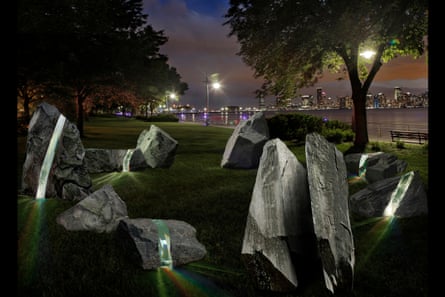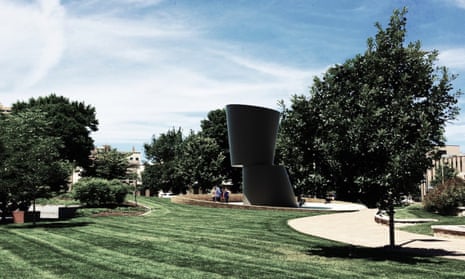While a number of Confederate monuments have been torn down – notably, in Wisconsin and Maryland following the rightwing rallies in Charlottesville – a number of new monuments are also going up across America.
This new school of public sculptures, monuments and plaques range from lifelike portraits of millennial rappers to boulders honouring the lives lost in the Orlando massacre. It proves a new vision is under way to commemorate America’s updated values.
“Right now, we’re in a self-conscious discussion of monuments,” said Kate Masur, a history professor at Northwestern University. “What we’re seeing is the takedown of monuments we have rejected and the building of new monuments with values that reflect people right now.”
On 8 December, the digital music service Spotify erected sculptures of three young rappers at the Brooklyn Museum called the RapCaviar Pantheon. Carved in Greek-style stone sculptures, the breakthrough artists 21 Savage, SZA and Metro Boomin represent a key moment in today’s hip-hop landscape.
“We’re treating our artists with the importance that ancient Rome treated its gods,” said Tuma Basa, Spotify’s global head of hip-hop. “Their music is forever, so why not immortalise their likeness?”
Over at the Hudson River Park in Manhattan, a new LGBT monument will honour victims of the Orlando massacre next summer. Created by the Brooklyn artist Anthony Goicolea, the project, which is spearheaded by the LGBT Memorial Commission, will have nine boulders fitted with glass prisms – which each reflect rainbows. The artist chose the park because it’s close to Christopher Street and its pier, a key location for LGBT activists after the Stonewall riots of 1969.

“This monument will serve as a communal space filled with light, colour and hope where the visitors can sit, mourn, love and remember for years to come,” said Giocolea, adding that it would “remember those who have been victims of hate, violence and intolerance, while celebrating the beauty of the LGBT community”.
In Des Moines, Iowa, a new monument honours the 12 African American lawyers who founded the National Bar Association in 1924, at a time when other legal organisations denied their membership. The new sculpture honours their organisation, which was founded “to strengthen and elevate” the black lawyer “in his profession and in his relationship to his people”.
A Monumental Journey is the name of the 25-tonne brick monument, by the Chicago artist Kerry James Marshall. A project of the Greater Des Moines Public Art Foundation, it’s shaped after a musical instrument used by the west African Yoruba people called the talking drum. To the artist, it represents a past breakthrough, present strength and future hope.
“It is to escape the dependency on a culture that has dominated you and oppressed you,” Marshall told ArtNEWS. “This is what it means to be equal; this is what it means to be free.”
One of America’s first anti-slavery monuments is also in the works, a proposed steel monument by the California sculptor Paul-felix Montez, who has designed a pair of broken chains. It’s expected to face the Lincoln Memorial Reflecting Pool in Washington.
“Everywhere I looked, there were endless war monuments, but how many are for peace and how many stand for basic human rights?” asked the artist. “That was my start of this effort.”
In New York’s Central Park, two new sculptures will soon commemorate two icons of the women’s suffrage movement.
#MonumentalWomen, which is backed by New York City Parks and the Stanton and Anthony Statue Fund, will bring to life two sculptures commemorating the pioneering women’s rights activists Elizabeth Cady Stanton and Susan B Anthony, who co-founded the National American Woman Suffrage Association. It was announced in November, marking the centenary of the women’s right to vote.
“Central Park hasn’t seen a new commemorative sculpture in more than half a century, so it’s fitting that we finally break the bronze ceiling with this long-deserved, long-awaited monument to the women’s suffrage movement,” said Gale Brewer, the Manhattan borough president.
“Now is the time when it’s most important that we honor Stanton, Anthony and the entire movement of women who fought for suffrage – and draw on their courage and determination as we continue the fight for equality.”
On 2 December, a new monument was unveiled in Austin to honour the veterans of recent wars. The Price of Liberty is a bronze sculpture showing a soldier saying goodbye to his wife and child while being carried away by an angel, which some interpret to be Lady Liberty. The Oklahoma artist Sandra Van Zandt created the 20ft-tall bronze sculpture to pay tribute to the 225,000 Texan Americans who served in Iraq and Afghanistan. The project was funded by private donations.
In Virginia, a large plaque was recently erected to remember Ota Benga, a Congolese man who was brought to America in 1904 by a Presbyterian missionary. Benga was displayed at the St Louis World’s Fair, and subsequently presented in the “Monkey Room” of the Bronx Zoo, as his small, 4ft 9in frame categorised him as a “pygmy”.
Outraged African American ministers placed Benga in a Brooklyn orphanage until he was brought to the Virginia town of Lynchburg to live with Hunter Hayes, president of the Virginia Theological Seminary and College. After living and studying in Virginia for six years, Benga wanted to return to Africa, but the first world war prohibited all passenger ship travel and as the plaque reads: “Despondent over his inability to return to Africa, he committed suicide in 1916.”
To Masur, the American conversation about monuments should have started sooner.
“It’s not a plausible argument to leave up monuments that are about the preservation of slavery,” she said. “As the drama was unfolding in Charlottesville, and since the shooting in South Carolina, people have been educating themselves – and each other.”
“Just as putting up new monuments is a new vision of who we are, taking them down is not erasing history. It’s different from ‘we don’t want to remember the past,’” she said. “Communities are rejecting monuments that don’t stand for their current values.”
